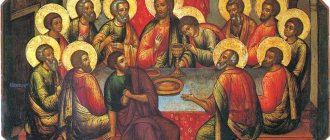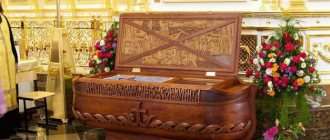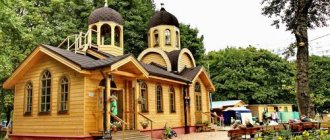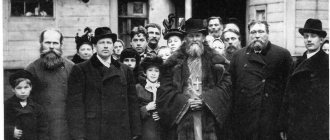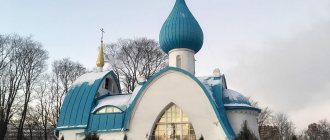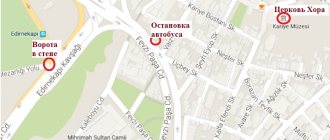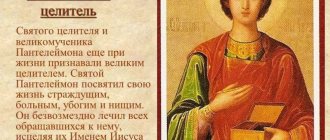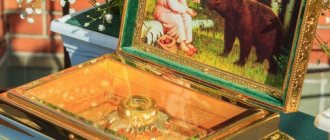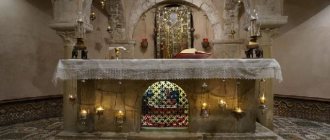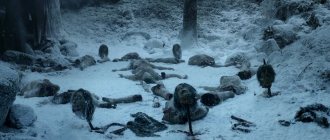Life
Righteous Theodore Ushakov was born on February 13, 1745 in the village of Burnakovo, Romanovsky district, Yaroslavl province. His parents were pious and deeply religious people; they considered the main condition for raising children to be the development of religious feelings and high morality in them. 1775 was the year of the creation of a regular linear Russian fleet on the Black Sea. In three years, the admiralty, port and city of Kherson were built 30 versts from the mouth of the Dnieper. In August 1783, 38-year-old captain of the second rank Fyodor Ushakov arrived here. And when Crimea was finally annexed to Russia (at the end of the same year), Catherine II issued a decree on the construction of new fortifications on the southern borders, including the large fortress of Sevastopol, with an admiralty, a shipyard, a port and a settlement. In August 1785, the 66-gun battleship St. Paul entered Sevastopol Bay with captain of the first rank Fyodor Ushakov on board. Two years later, in 1787, the war with Turkey began. For the first time, the small Russian fleet in open battle defeated significantly superior enemy forces, bringing the Ottoman Porte into extreme fear and horror. This was greatly facilitated by the personal courage, skillful mastery of tactics and outstanding personal qualities of Captain Fyodor Ushakov, who took charge of the battle. The Black Sea Fleet won brilliant victories one after another. Fedor Ushakov at the beginning of 1790 was appointed commander of the Black Sea Fleet. Four years later, the Russian-Turkish war ended with the fourth brilliant victory of Rear Admiral Ushakov at Cape Kaliakria, for which he was awarded the Order of St. Alexander Nevsky. One of the strongest Turkish fleets at that time was completely destroyed, and on December 29, 1791, the Turks signed a peace treaty in Iasi. In 1792, Fyodor Ushakov was elevated to the rank of rear admiral by Empress Catherine II. In 1796, Emperor Paul I ascended the Russian throne. At that time, revolutionary France turned to the conquest and enslavement of neighboring powers. In 1798, the famous Mediterranean campaign began, in which Fyodor Ushakov showed himself not only as a great naval commander, but also as a wise statesman, a merciful Christian and a benefactor of the peoples he liberated. Liberating the Ionian Islands from the French one after another, the rear admiral, with the support of local residents, also captured the island of Corfu, which was considered impregnable. For the victory at Corfu, Emperor Paul I promoted Fyodor Ushakov to full admiral. This was the last award he received from his sovereigns. Crushing the French army on land and sea, Russian sailors and paratroopers took the city of Bari, and then Naples. Neapolitan Minister Mishuru enthusiastically wrote to Admiral Ushakov: In 20 days, a small Russian detachment returned two-thirds of the kingdom to my state. Of course, there was no other example of such an event: only Russian troops could perform such a miracle. What courage! What discipline! What meek, amiable morals! They are idolized here, and the memory of the Russians will remain in our fatherland for eternity. As Fedor Fedorovich himself wrote about his service to the Russian fleet, during the entire period of his command not a single ship was lost, not a single one of his people was captured. The great admiral died in 1817. His exploits and highly moral life are not forgotten in his native Fatherland. The highest award for sailor warriors was the Order of Admiral Ushakov. In 2001, Fyodor Ushakov was canonized by the Russian Orthodox Church.
Icon of Fyodor Ushakov
Some Orthodox icons are painted from ordinary people who, through their deeds, prove their love for God. One of these individuals canonized is the warrior Fyodor Ushakov, who showed courage, defended people and was devoted to the Orthodox faith.
Fyodor Ushakov not only made an invaluable contribution to saving the Fatherland from enemies, but also brought many innovative ideas that helped the Russian army win many battles. A brilliant commander and fearless warrior, at the end of his life he devoted all his strength and savings to helping the wounded and those in need of protection from enemies and destroyers during wars.
History of the icon
Fyodor Ushakov was canonized for his many exploits. His record of successes includes many brave decisions that helped the troops defeat their enemies. True love for people and his Motherland, as well as prayers to the Higher Powers, more than once rescued the commander and led him to victory and success. Before any battle, he always asked for the protection of the Higher Powers and received Divine support in his campaigns.
Being at an advanced age, Admiral Ushakov refused to participate in the military campaign, remaining in the rear. There, with his savings, he organized a hospital and, to the best of his ability and ability, helped everyone in need. In 2000, Patriarch Alexy II blessed Fyodor Ushakov to be canonized, and in 2001 the admiral was canonized.
Where is the icon
The icon of the saint is located in many cities of Russia. You can venerate the image in Saransk, Volgodonsk, Volgograd, Moscow, Sochi, St. Petersburg. Many churches and cathedrals were built bearing the name of the famous warrior. Also in the Novgorod region, in the village of Molochkovo, there is a bathhouse built in honor of Fyodor Ushakov.
Description of the icon
The image of the saint is painted as close as possible to the historical figure. The holy warrior is depicted in a military uniform with awards he earned in numerous battles. The half-length image of Fyodor Ushakov looks majestic. In his right hand there is a scroll with prayers as a symbol of faith and protection of the Higher Powers, in his right hand the warrior holds the weapon with which he fought the enemies of his Fatherland. The icon is an impeccable example of the canonical writing of saints, and the warrior is depicted with all scrupulousness and care.
How does the icon of St. Fyodor Ushakov help?
In front of the icon of the saint, they pray for the repose of relatives who gave their lives in the war for the good of the Motherland and people, for the health of soldiers serving in hot spots and serving in the army. They resort to the help of a saint to strengthen faith, gain courage and wisdom.
Prayer before the image
“Holy warrior Fedor, save and preserve the lives of our husbands and sons serving military service. Give them wisdom and courage, protect them from enemies and help them do good deeds. Bless them for their feats of arms and do not abandon them in a moment of mortal danger. Pray for the peace of the soldiers who withstood the enemy pressure with honor and defended the Fatherland and people from death and ruin. Amen".
Celebration date
The church celebrates the veneration of the icon of Fyodor Ushkov twice: on October 15 , the day of his death, and on August 5 , when the warrior was canonized. On these days, a festive liturgy is celebrated, and everyone can honor the memory of the great warrior and righteous man.
The patron saint of all military men, Fyodor Ushakov, is an example to follow. His strength and power, supported by faith in a Higher Power, helped him cope with many difficulties and mortal dangers. You can pray to the saint in your own words. The main thing is that they come from a pure heart.
“He dedicated his life to God”
Valery Nikolaevich Ganichev invited me to the House of Writers on Komsomolsky Prospekt for a conversation. Large cabinet with icons. On one of the tables there is a typewriter, magazines and books. However, books are everywhere here. Here time seemed to stand still. In the left corner there is a large picture: Valery Nikolaevich is depicted in a chair against the background of the icon of the holy righteous Theodore Ushakov, whose name the Russian writer glorified. And again it thundered, and again not only throughout Russia, but throughout the whole world. His enemies feared him, his contemporaries admired him, he was loved by his subordinates and hated by cowards and careerists, of whom there were no less then, in the 18th century, than today.
Valery Ganichev is the author of the books “The Invincible Ross”, “About the Russian”, “The Word. Literature. Fatherland", "Ushakov". He collected materials about the life of the admiral for many, many years, so that they became not only books, but also the basis for glorifying Theodore Ushakov as a saint.
St. Theodore Ushakov destroys the Turkish fleet. Artist: Natalya Klimova
– Valery Nikolaevich, you have studied the life of Fyodor Ushakov for more than 20 years. What attracted you to the Russian admiral?
– As for Saint Theodore Ushakov, I have been studying the life and deeds of Admiral Ushakov for more than 50 years. Since I found myself in Nikolaev, the center of our shipbuilding industry, in 1957, I have visited the local Naval Museum (very good, by the way), in front of which there are busts of Russian admirals, including Ushakov.
At first I was only interested in his strategic and military talent. I was captivated by two films released at that time: “Ships Storm Bastions” and “Admiral Ushakov.” These films are wonderful in their own way, although with a significant ideological background, with an attempt to revolutionize Ushakov, but they provided a certain historical outline. Then I began to look for materials about his time in the Black Sea Fleet. And after all, he headed not only the Black Sea Fleet, but also the Southern Admiralty Board - there was such an institution in the 18th century, a kind of Ministry for the Affairs of the Southern Fleet of Russia.
Valery Nikolaevich Ganichev
- What was the significance of the annexation of these southern lands to Russia?
– As you know, the Black Sea basin was then Turkey’s sphere of influence. Although long before the Turks this region was Slavic, and the Arabs called the Black Sea the Russian Sea. According to my version, set out in the novel “Ross the Invincible,” after a conversation with Lomonosov, Catherine came up with the idea, following Peter the Great, who “cut a window to Europe” to the west, to make such a “window” for Russia and to the south: Lomonosov once told her that in a Russian bright room there is always a window at noon - to the south. Let’s not forget that Catherine emphasized in every possible way: she is the successor of Peter’s work.
During the two Russian-Turkish wars of 1768–1774 and 1787–1791, Russia not only liberated these southern lands - they were empty, vast steppes: the regions of present-day New Russia - the Tauride Territory - were annexed to the Russian Empire and populated by people from the Oryol, Voronezh, Chernigov province... Both serfs and free people settled here. This is how the Russian Tauride region, later known as Novorossiya, was formed. We must not forget the history of these lands, which is very important for current geopolitical disputes. First, these lands were populated. Secondly, beautiful cities were built there: Melitopol, Mariupol, Kherson, Nikolaev, Odessa, Tiraspol.
And another important act is connected with the development of this region: the Russian Black Sea Fleet was created.
And the erected Sevastopol became the base of the Black Sea Fleet. And so Captain 1st Rank Fyodor Ushakov was appointed there in 1783, transferred to a new duty station from the Northern Baltic Fleet.
– Has Ushakov been to these parts before?
- Yes, and more than once. Ushakov went to Kerch, Taganrog, Balaklava. So these were familiar places for him. As, by the way, is the Mediterranean Sea. Let us remember that he was a participant in that Mediterranean campaign, when Russian ships tried to enter the Black Sea through the Dardanelles, but Turkey did not let them in, and they had to return to Russia through the Atlantic and Baltic.
And now he was appointed commander of the frigate "St. Paul". This ship was built in Kherson, then floated down the Dnieper to the Black Sea, equipped with artillery and then arrived in Sevastopol...
And in his service during these years, Ushakov proved himself to be an excellent administrator, aware of his responsibility for the people entrusted to him and caring for them.
The plague was then raging in the south of Russia. The pestilence killed thousands of people. Ushakov showed extraordinary management, and thanks to the strict discipline he established and the measures he took, not a single sailor died. What did he do? He took the ship away from the shore, lined it with dry steppe grass and set it on fire so that it would constantly smoke. He put out barrels of vinegar with which everyone was supposed to rub themselves. Organized isolation wards. And note: he received his first order from Empress Catherine II for this first feat of saving civilians. It was the Order of St. Vladimir.
– How many battles did Fedor Ushakov win?
– He won 43 battles. None of the naval commanders in the world had so many victories! There was no such thing! But these victories became possible not only thanks to his personal courage, his talent as a tactician, but also his gift as an educator. His crew was well prepared and trained. Even during the plague, he taught sailors to climb the mast, set the sails...
– What victory of Admiral Ushakov, in your opinion, was the most brilliant?
– The most amazing victory, which is included in all textbooks, was at Cape Kaliakra in Northern Bulgaria in 1791, during the Russian-Turkish War.
Battle of Cape Kaliakria July 31, 1791 Artist A. Depaldo
Ushakov then made a maneuver, passing between the shore and the Turkish squadron, preventing Turkish batteries from shooting at our ships from the shore, because then the ships of the Turks themselves would come under Turkish fire. He surrounded, faced the wind and completely defeated the Turkish squadron, commanded by Ali Pasha, who promised the Sultan to bring Ushakov in chains to Istanbul. And the Turkish Sultan, on the night when he received the news that his fleet was completely destroyed, signed the famous Treaty of Yassy, according to which the lands to the right of the Dnieper went to Russia. Well, Crimea was declared Russian back in 1774 under the Kuchuk-Kainardzhi Peace Treaty. And Ushakov was one of the most prominent promoters of this direction of Russian policy. By the way, for these victories the Turks, with admiration and even with some fear, nicknamed Ushakov the Invincible Ushak Pasha. This explains the following fact: when at the end of the 18th century Paul I concluded an alliance with Turkey against Jacobin France, he appointed Ushakov as commander of the joint Russian-Turkish squadron.
– Did Türkiye easily agree to this?
– Türkiye went for it. She might not have agreed if some other naval commander had been placed at the head of the squadron. But they knew Ushakov’s strength. And as part of this military expedition, Ushakov passed through the Bosporus and Dardanelles straits and began to occupy the Ionian Islands. They are found in the Ionian and Adriatic seas. This is part of the former Venetian Republic, which the French captured in 1797, garrisoning it. Ushakov gradually liberated the islands one after another from October 1798: Zante - a very powerful first island, Kefalonia - a beautiful island, Lefkada... There was only one island left, but what one! It was the island of Corfu.
Valery Ganichev.
Ushakov (ZhZL) – Island of St. Spyridon of Trimifuntsky!
– Yes, the island of St. Spyridon of Trimythous. The siege of the island was difficult, there was not enough food and money. Ushakov allocated his own funds to purchase food and warm clothes. There were no warm clothes, so we bought women's robes. It would seem, the southern island, the southern sea, why warm clothes? But quite unexpectedly, snow fell on Corfu. Wet snow. It was cold.
And so on February 19, 1799, Ushakov stormed and took the fortress.
Ushakov sent the French garrison captured in Corfu... home, but with only one condition - not to fight again against Russian troops
They took a number of actions. He raised up the entire Greek population. I visited the Patriarch of Constantinople and asked for help with an appeal to the Greeks. And he skillfully built an attack on other islands so that the French garrisons located there would either surrender or flee to Corfu anyway. He took Corfu on one day - February 19th. The French capitulated. Ushakov put the entire French garrison on barges and sent them home, but with only one condition - not to fight against the Russian troops anymore. This was such a manifestation of humanism, such chivalry, absolutely exceptional.
The independent Republic of the Seven Islands was formed on the Ionian Islands. Ushakov proved himself here not only as a naval commander, but also as a strategist, politician, diplomat, and statesman.
– Tell us more about this page of the biography of our naval commander.
– Ushakov gave these islands the first constitution. Democratic constitution! But in Russia at that time it was impossible to even think about a constitution. The Constitution of the Republic of the Seven Islands was the most democratic constitution of the 19th century in Europe.
The march to Corfu is a great Orthodox campaign to liberate fellow believers
Ushakov gave the republic a state language - Greek. The majority of the islands' population were Greeks. But the local elite were Venetians. And therefore - Catholic. And the most important act of Fyodor Ushakov: he returned the Orthodox diocese to the islands. This was a big and serious step. Because there has been Catholicism on the islands since the 1400s. A metropolitan was elected in Kerkyra, and the Orthodox page in the history of the islands began. I evaluate this campaign as a great Orthodox campaign to liberate fellow believers. After all, the French revolutionaries were atheists, they mocked believers, including Orthodox Christians. And unlike the European crusades, which were launched ostensibly in the name of Christ, but in fact, as we remember, in one of these campaigns Constantinople was sacked, and the Orthodox crusaders were destroyed as infidels, Ushakov did not oppress anyone. He left everyone on the islands: both Catholics and people of other confessions. But he accomplished a very high Orthodox mission.
– What other deeds did our famous warrior commit?
– A page that little is known about: Ushakov and his sailors liberated first the city of Bari, then Naples, from the French. And a fact that almost no one knows: Ushakov liberated Rome. We know that the soldiers of Count Saltykov liberated Berlin, Alexander I liberated Paris. And few people know that Rome was liberated by Russian troops. Minister of War D.A. Milyutin, a very smart man, said in the middle of the 19th century: “Behind the brilliance of Suvorov’s victories, they somehow forgot the brilliance of Ushakov’s victories.” Suvorov at this time was liberating Northern Italy.
Admiral F.F. Ushakov.
Artist P. Bazhanov - Suvorov dreamed of being a midshipman with Ushakov...
- Yes, in his famous report Suvorov wrote: “Hurray! To the Russian fleet!.. Now I say to myself: “Why wasn’t I at Corfu, at least as a midshipman!” Ushakov and Suvorov knew each other from the Black Sea theater of military operations. And according to some reports, Ushakov was part of the rowing flotilla during the assault on Izmail. By the way, there is a painting depicting Ushakov and Suvorov on the seashore.
– Many people in the world know the English Admiral Nelson well. They praise him and talk about his exploits. But Fyodor Ushakov was his contemporary. Can you compare these two military leaders?
– Nelson, of course, is a great naval commander, but he lost a number of battles. He envied Ushakov. Although he was recognized as a military genius. I even negotiated with him.
But Nelson, as a person, had many negative qualities. For example, he ordered the execution of French prisoners and Italian republicans captured after the liberation of Naples - by the way, by Ushakov’s Russian squadron. It was a real massacre.
– Valery Nikolaevich, do the Greeks themselves today remember who fought and died for them?
In the end, the Corfu archive brought me documents for the years 1798–1799, and on the folder it was written: “Russian-Turkish occupation”!
– Working on books about Admiral Ushakov, I collected information in the archives of Tambov, Saransk, Leningrad, Kherson, Odessa, Nikolaev, Sevastopol, and managed to make my way to Corfu in 1988. In the Corfu archive I asked: “Give me the documents about Ushakov.” They answer me: “No documents.” I again: “Give me the documents from 1798.” They answer me again: “There are no such people!” In the end, they brought me documents for 1798, and on the folder it was written: “Russian-Turkish occupation.” Of course, I flushed: “Shame on you! Ushakov freed you, he gave you independence. He gave the constitution, the Greek language, the metropolis, and you write: “Occupation.” The employee blushed and said: “You know, this definition was given by the British. Corfu was their protectorate. They gave us their chronology, their definitions of periods of history.”
The British are “well done,” they think this way: where they are, there is freedom and democracy, and where others are – and especially Russia – it is occupation!
F.F. Ushakov
When we held the first conference dedicated to Ushakov in Greece, one member of the Athens parliament stood up and said: “We know nothing about this. Some Ushakov freed someone, some kind of constitution... Where are the documents?” A year later he apologized to us! And after the translation of the first version of my book about Ushakov, which tells about the liberation of Corfu and the transformations on the island, the Greeks, including at the church level, recognized Ushakov’s merits. Although, I must honestly say, the people have always revered Ushakov.
The British think like this: where they are, there is freedom and democracy, and where others are – and especially Russia – it is occupation!
Now days in memory of Admiral Ushakov are held annually in Corfu.
In 2002, we erected a monument to the naval commander in Corfu. This was the first monument to him on the islands. In 2004 - the second, already on the island of Vido. In 2013 - on the island of Zante.
And it’s remarkable that the monument in Corfu stands near the temple of St. Spyridon of Trimythous. Every year we celebrate Liturgy there. By the way, Saint Spyridon was also the patron saint of our soldiers. The famous Moscow street Spiridonovka is evidence of this.
Ushakov walked with the monks and carried the relics of Saint Spyridon of Trimifuntsky
At the very first procession of the cross to Corfu, Ushakov walked with the monks and carried the relics of Saint Spyridon of Trimifunt. This is very significant.
Holy Righteous Theodore Ushakov
Our holy warrior was faithful to the Church throughout his life. And from the Ushakov family, not only the warrior Theodore was glorified, but also his uncle, who had a huge influence on him: the Monk Theodore (in the world Ivan Ushakov) was the abbot of the Sanaksar monastery. And the fact that Admiral Ushakov was buried in this monastery saved it from ruin during the years of persecution.
– When did it become clear that Theodore Ushakov needed to be glorified as a saint?
– After a series of conferences and meetings with monks, after studying documents, the spiritual component of the life of the Orthodox warrior Theodore Ushakov became clear.
Every time before the campaign and after its completion, he performed prayers and services together with the sailors. In one of the Greek documents I found there are the following words: “How wonderful that the Russians are led by such a great Orthodox general as Ushakov.” As many as seven Greek churches were provided to the sailors and soldiers of Ushakov. Why? Because everyone was praying! And when Ushakov and Prince Volkonsky stood in front of the sailors, it was an edifying example for them.
As many as seven Greek churches were provided to the sailors and soldiers of Ushakov. Why? Because everyone was praying!
We discussed the need to glorify Theodore Ushakov with Bishop Barsanuphius, then Bishop of Saransk, and now Metropolitan of St. Petersburg and Ladoga. I told the bishop: “He is a saint! All the facts are there, there are holy remains.” Vladyka to me: “Intercede!” I wrote a letter to Patriarch Alexy II. His Holiness received me. I have stated all the facts. And the patriarch said: “If our fleet receives such a heavenly patron, it will be extremely important.” And at that time we had a problem with the fleet: we lost the Baltic, we lost the Black Sea Fleet in Sevastopol. Then the patriarch added: “Not only the Orthodox fleet, but all Orthodox people will rejoice.”
The glorification of Theodore Ushakov as a saint was also supported by the revered elder Jerome, who labored in the Sanaksar monastery.
And so on August 5, 2001, Metropolitan Kirill - this is also very providential: the future His Holiness Patriarch of the Russian Church - served the rite of glorification of the holy righteous Theodore Ushakov.
– Tell us about the last years of the saint’s life.
– After retiring, Ushakov left St. Petersburg. Nobleman, rich! It would seem, why leave the capital? And he went into the wilderness. He built a house near the Sanaksar Monastery. As Bishop Tambov wrote, Theodore Ushakov “spent entire weeks in his cell.” So, in fact, he now dedicated his life to God.
He was a great benefactor. He distributed his wealth to the wives of killed officers, retired soldiers, and the creators of the hospital. And for this, Feodor Ushakov was officially glorified as a saint of the Russian Orthodox Church in 2001: we celebrate his memory on October 2/15.
And I will be the first to tell you about the great discovery. We discovered a lifetime portrait of Ushakov!
